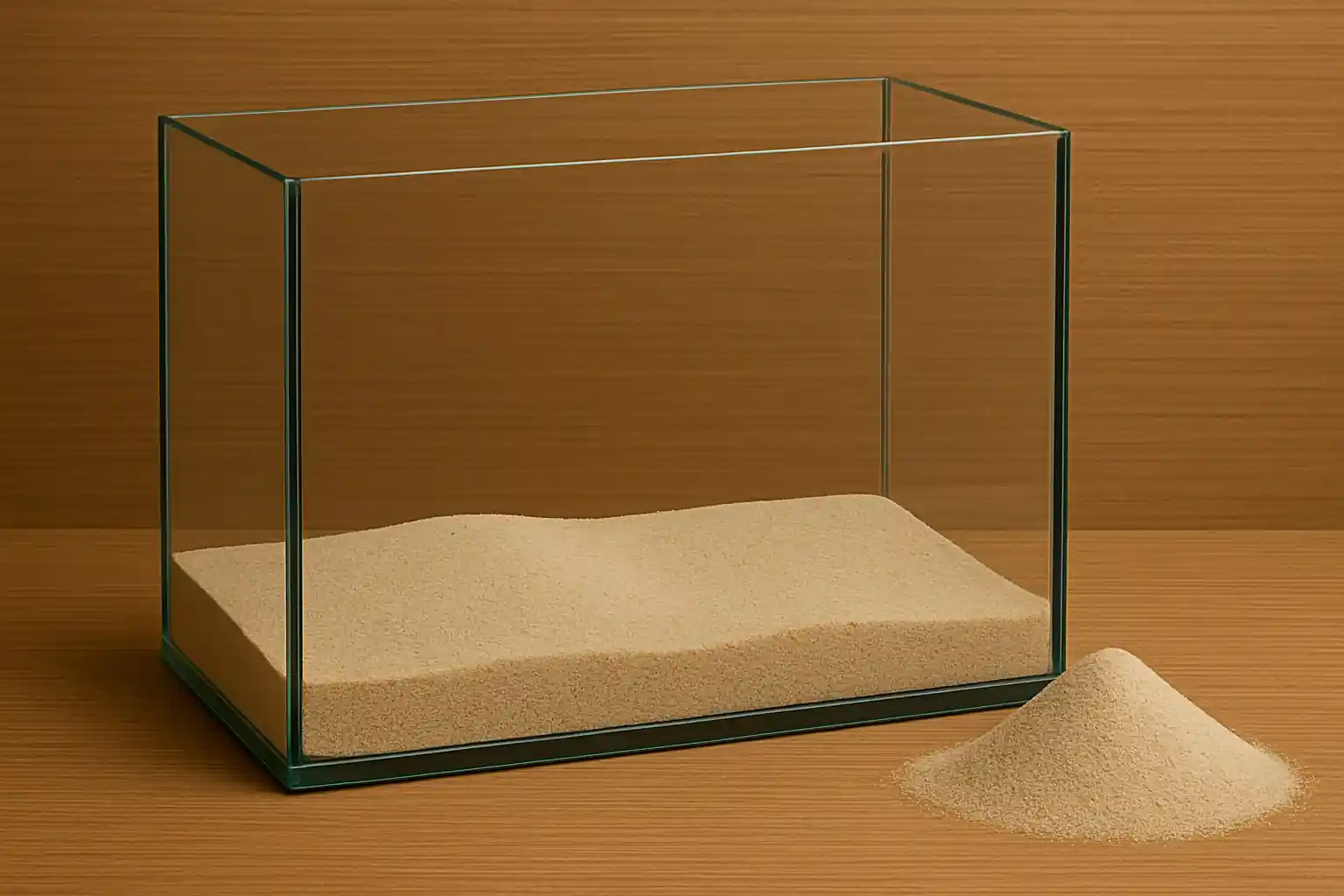
Aquarium Sand: Complete Guide to Safe Use, Aesthetics & Maintenance
Introduction
Aquarium sand is more than just decoration — it’s a foundational component that directly impacts the health of your aquatic ecosystem. Whether you’re setting up a planted tank, a biotope, or a species-specific aquarium like one for cichlids or bettas, the choice of sand affects water chemistry, filtration, and fish behavior.
In this comprehensive guide, we’ll cover everything aquarists need to know about aquarium sand — from types and grain sizes to cleaning, layering, compatibility with plants, and maintenance best practices. Whether you’re a beginner or intermediate enthusiast, this article will help you choose the right sand substrate for your tank goals.
What you’ll learn in this lesson
- Types of aquarium sand and their pros and cons
- How to choose the right grain size
- Differences between sand and gravel
- Best sand options for planted tanks
- How to properly layer and rinse aquarium sand
- The impact of sand on water parameters
- Fish species that prefer sandy substrates
- Maintenance tips and vacuuming techniques
- Common mistakes to avoid with aquarium sand
- Eco-friendly and natural sand choices
Types of Aquarium Sand
There are various kinds of sand used in aquariums, each with different properties. Understanding their characteristics helps ensure compatibility with your tank setup.
1. Silica Sand
- Made from finely ground quartz
- Inert and doesn’t affect water chemistry
- Affordable and widely available
- Can compact over time
2. Play Sand
- Often used in children’s sandboxes
- Very fine texture
- Must be rinsed thoroughly
- Can cause cloudy water if not properly cleaned
3. Aragonite Sand
- Derived from crushed coral
- Raises pH and hardness — ideal for African cichlids or marine tanks
- Contains calcium carbonate
- Not suitable for softwater aquariums
4. Black Sand
- Often dyed silica or volcanic sand
- Aesthetic appeal with dark substrate
- Enhances plant and fish colors
- Watch for brands with inert coatings only
5. Specialized Planted Tank Sand
- Nutrient-rich or porous for root growth
- Often paired with soil layers or additives
- Brands: ADA Aqua Soil Powder, Tropica Aquarium Soil Powder
Sand vs Gravel: Which Should You Choose?
| Feature | Sand | Gravel |
|---|---|---|
| Grain Size | Very fine | Coarser |
| Suitable for Plants | Good for root spread | Needs root tabs |
| Fish Compatibility | Better for burrowing species | Some fish may swallow gravel |
| Cleaning | More difficult (clogs vacuums) | Easier to vacuum |
| Compaction Risk | Higher | Lower |
Choosing the Right Grain Size
Grain size plays a key role in oxygen flow, water clarity, and root penetration.
- Fine Sand (0.1–0.5 mm): Best for fish that sift or burrow; may compact
- Medium Sand (0.5–1.0 mm): Good balance for most tanks
- Coarse Sand (1.0–2.0 mm): Improves flow but less natural for some fish
Tip: Avoid ultra-fine powders as they can turn cloudy and clog filters.
Best Aquarium Sand for Planted Tanks
While sand alone doesn’t provide nutrients, you can still use it effectively in a planted setup:
- Use root tabs beneath the sand
- Combine with a nutrient layer (e.g., aquasoil underneath)
- Choose porous sands for root penetration
- Avoid sand with high compaction (e.g., play sand)
Recommended: Tropica Aquarium Soil Powder topped with fine black sand.
How to Layer Aquarium Sand Correctly
Layering helps maintain stability and supports root systems.
- Base Layer (optional): Nutrient-rich soil
- Middle Layer: Fine lava granules or porous sand for drainage
- Top Layer: Decorative sand, 2–4 cm thick
Avoid layering too high, which may lead to anaerobic pockets.
How to Rinse Aquarium Sand
To avoid cloudiness, rinse thoroughly before adding sand to your tank.
- Place sand in a bucket
- Fill with water and stir
- Pour off the cloudy water
- Repeat until water runs clear
Pro Tip: Use a sieve for finer control when rinsing large batches.
Aquarium Sand and Water Parameters
Different sands can affect your tank chemistry:
- Aragonite: Raises pH, KH, and GH
- Silica/Play Sand: Neutral (inert)
- Volcanic Sand: Slightly acidic in some cases
Always check how your chosen sand interacts with your water type.
Best Fish Species for Sandy Substrates
Many species benefit from sand, especially those that forage, sift, or dig.
- Corydoras Catfish – soft sand prevents barbels damage
- Kuhli Loaches – enjoy burrowing
- Geophagus – natural sand sifters
- Rams and Apistogrammas – prefer soft substrates
- Snails and Shrimp – less stress on soft sand
Cleaning and Maintenance Tips
Sand requires a gentler approach than gravel.
- Use a gravel vacuum with reduced flow
- Hover above the sand surface
- Stir sand lightly during water changes
- Avoid overfeeding to reduce debris accumulation
Warning: Never let food decay under compacted sand — it causes anaerobic gas pockets.
Common Mistakes with Aquarium Sand
- Using unwashed play sand → cloudy tank
- Layering too thick → compaction and anaerobic zones
- Forgetting root tabs for planted tanks
- Choosing incompatible sand for your water chemistry
- Skipping rinsing → initial mess and filter issues
Sand Color and Aquascape Aesthetics
Color affects perception of depth and vibrancy:
- White Sand: Clean, minimalist look; algae shows more
- Black Sand: High contrast, enhances colors
- Brown/Tan Sand: Natural and neutral appearance
- Red Lava Sand: Good in biotopes or jungle-style scapes
Use color variations to create paths, shadows, or sloped depth illusions.
Eco-Friendly and Natural Sand Options
For sustainable choices:
- Look for inert sands free from dyes and chemicals
- Choose natural quartz-based sands
- Avoid coral-sourced sand if not needed
- Check packaging for eco-certification
Some aquarists reuse sand after sterilizing it in boiling water or bleach solution — only do this carefully.
Sand for Biotope Aquariums
Sand helps recreate natural habitats.
- Amazon Biotope: Fine beige or brown sand
- Lake Tanganyika: Aragonite sand for high pH
- Southeast Asia: Mix of sand and leaf litter
- Brackish Biotopes: Silica sand mixed with crushed coral
Can You Mix Sand and Gravel?
Yes — you can create visual interest or functional layers.
- Sand bottom + gravel accents: Keeps plants anchored
- Gravel base + sand cap: Avoids compaction
- Use mesh barriers if you want clear separations
Aquarium Sand vs Soil: A Quick Comparison
| Feature | Sand | Soil (Aquasoil) |
|---|---|---|
| Nutrients | None (needs root tabs) | High, ideal for plants |
| Water Parameters | Inert or minor pH effect | May lower pH initially |
| Lifespan | Very long | Depletes nutrients over time |
| Maintenance | Easier, doesn’t break down | May create mess during setup |
| Fish Compatibility | Ideal for diggers | Not great for sifters |
DIY Sand Substrate Mix
Want to mix your own?
- Inert base sand (quartz or silica)
- Add fine lava granules (for flow and bacteria)
- Insert root tabs for nutrients
- Cap with cosmetic black or beige sand
Custom mixes allow aesthetics + function.
Tips for Aquascaping With Sand
- Use sand in the foreground for a clean open space
- Combine with stone hardscape for natural contrast
- Avoid steep slopes — sand shifts over time
- Support slopes with barriers or plants
Long-Term Considerations
- Stir sand regularly to prevent compaction
- Consider Malaysian trumpet snails for substrate aeration
- Vacuum lightly to maintain cleanliness
- Monitor plant health if using sand-only
Aquarium Sand for Shrimp Tanks
Shrimp prefer soft, inert sand:
- Fine grain for safe walking
- Avoid dyed sand
- Neutral pH preferred
- Pair with moss and driftwood
Tip: Use dark sand to highlight colorful shrimp.
Upgrading From Gravel to Sand
- Remove old substrate gradually
- Replace in sections during water changes
- Rinse new sand before adding
- Monitor parameters after swap
Key Takeaways
- Choose sand based on tank type, fish, and plants
- Rinse thoroughly to avoid cloudiness
- Combine with root tabs or soil for plants
- Avoid thick layers to prevent gas buildup
- Aesthetic choices impact visual impact
Conclusion
Aquarium sand is more than just a base layer — it’s a dynamic part of your aquarium’s function and style. Whether you’re building a planted scape, a biotope, or a species-focused environment, choosing the right sand helps your tank thrive.
From grain size and color to chemistry and cleaning, the right knowledge ensures you make the best substrate choice. And with so many beautiful, functional options available, aquarium sand offers both simplicity and depth for aquascaping success.
💬 Join the Conversation
Tag or write us on Instagram @AquariumLesson — we’d love to see your substrate setups and how you used sand in your aquarium.
👉 What’s your favorite aquarium sand color or brand?
FAQ
Is aquarium sand better than gravel?
It depends on your tank. Sand is better for certain fish and aesthetics; gravel is easier to clean and suits high-flow systems.
How deep should the sand layer be?
2–4 cm is enough for most tanks. Deeper layers require stirring or aeration.
Can I mix sand with soil?
Yes, but layering is key. Soil on bottom, sand on top.
Is black sand safe?
Yes — as long as it’s inert and not coated with harmful dyes.
Does sand affect pH?
Some sands (like aragonite) do. Most inert sands do not.
References
- Choosing the Right Substrate for Your Aquarium – Tropica Aquarium Plants
Offers expert advice on different substrate types, including sand, and their effects on plant growth.
https://tropica.com/en/guide/ - Sand vs Gravel in Aquariums – Aquarium Co-Op
A detailed comparison of sand and gravel, discussing filtration, cleaning, and plant suitability.
https://www.aquariumcoop.com - Aquarium Substrate: Everything You Need To Know – FishLab
Covers pros and cons of sand, installation tips, and maintenance strategies.
https://fishlab.com/aquarium-substrate/ - Using Sand as a Substrate in Planted Tanks – Aquasabi Blog
Describes the use of lava granules and sand in layered aquascaping, with practical examples.
https://www.aquasabi.com/blog - The Complete Guide to Aquarium Substrates – The Spruce Pets
Explains various substrate options, with a section dedicated to fine sand and its role in fish behavior.
https://www.thesprucepets.com/
Inspire someone – share this post
